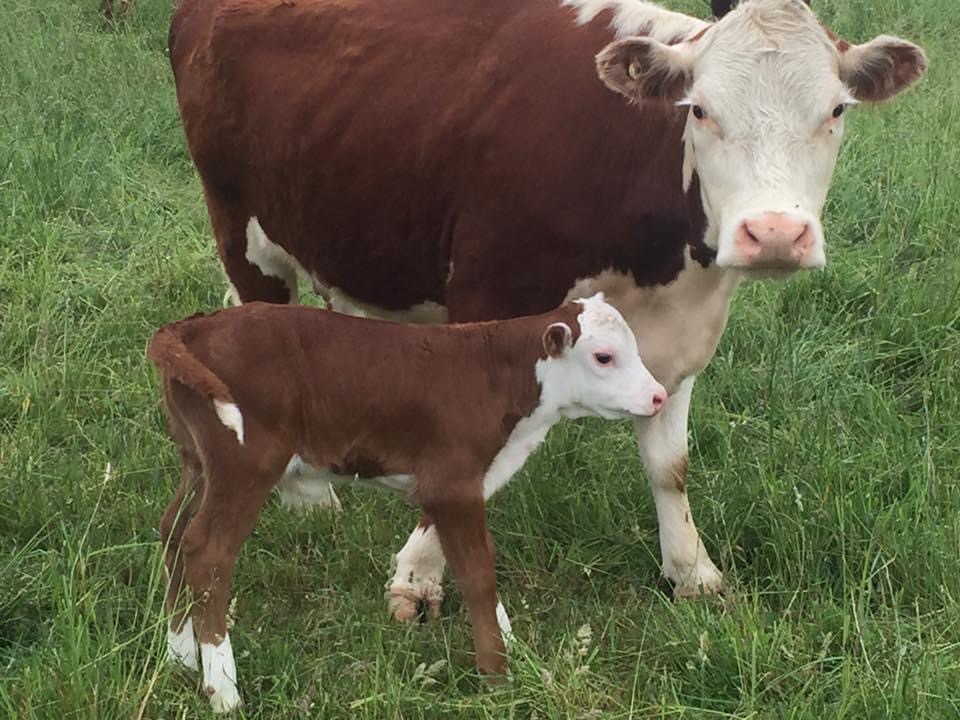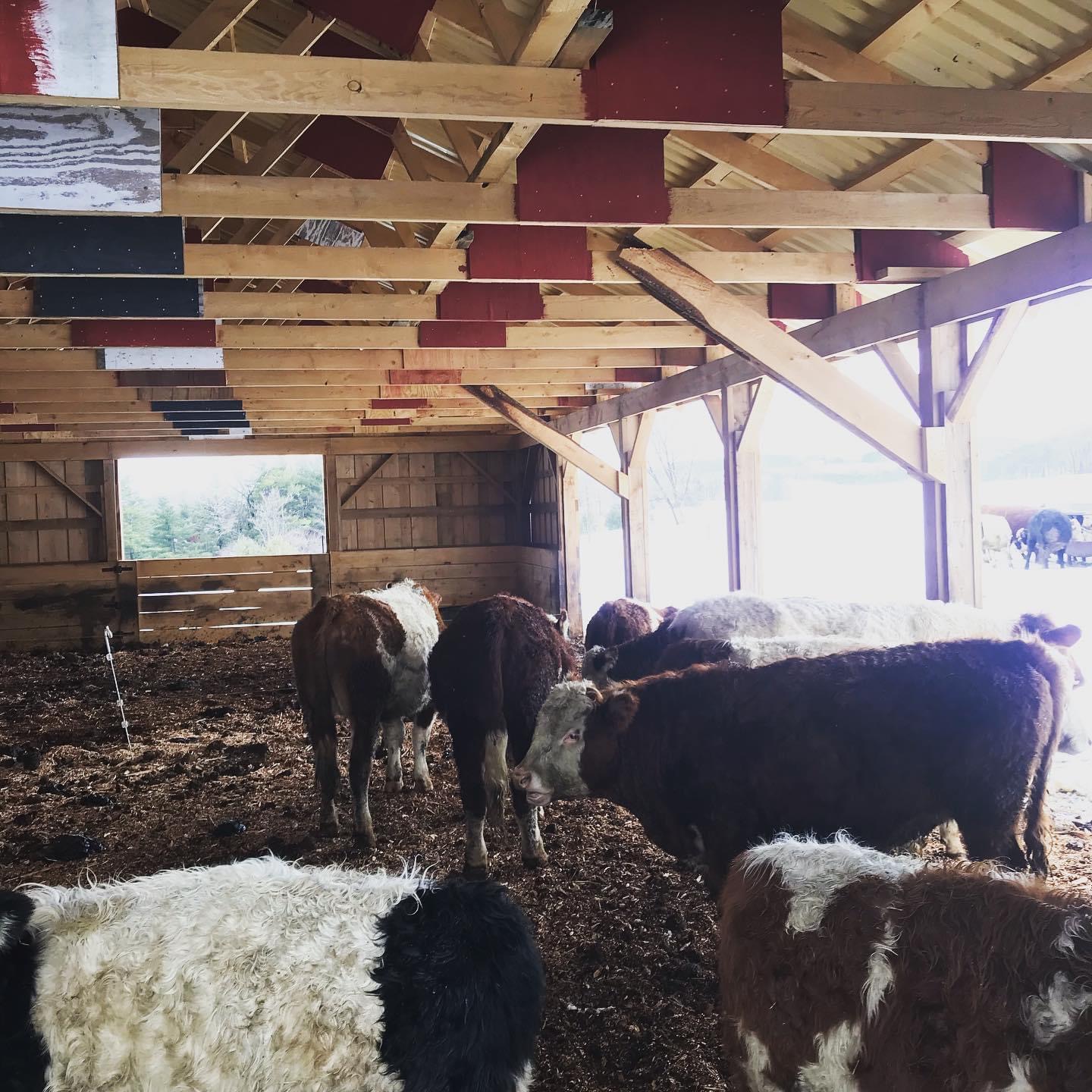Some Considerations for Beef Cattle Calving
In part four of our “What’s Your Beef?” series on raising cattle on small farms, we present several management factors for your beef cow-calf herd to take into consideration.

Good planning will result in healthy, robust calves.
Rich Taber / CCE Chenango
This is the fourth installment in our ongoing series “What’s Your Beef?” to assist new and beginning beef cattle producers. Previous installments can be seen in recent editions of the Small Farm Quarterly. As you read this edition the springtime will be emerging from our long, cold, northern winters. There’s nothing more exciting than to see newly born baby beef calves scampering around pastures, chasing each other, and nursing their mothers. It’s like a tonic, raising our spirits and making us glad that we are farmers. Another thing to consider is that your only income in a beef cow calf herd, or paycheck if you will, comes from that beef cow having a healthy, well fed, fast growing calf that can be marketed sooner or later. So, I am going to present several management factors for your beef cow calf herd to take into consideration.
The first consideration is when will you have your cows start calving? Some people start in the dead of winter, as in February or March. You can do this, but you must have adequate calving facilities for the cows to calve in. You cannot have cows giving birth out in the harsh, snowy conditions of winter without heavy death losses. Baby calves are robust little creatures, and once the mother cow licks them off and they get a feeding on colostrum in their stomachs they usually do well. It’s just that you can’t have them being born out in the field with deep snow, wet rain, sloppy mud etc. However, if you have the barn space, calves born earlier in the year have a better chance of reaching marketable weights as feeder calves before the next winter sets in. An alternative is to have the cows calve later in the spring, such as April onward. Even then April weather can still be challenging, but usually not too bad. I had one of my first calves born this last April 30th and it snowed! The bulk of my calves are born in May and June. This makes it challenging to get them to a marketable weight during the same calendar year. Then there is that one creature that we all end up beating our heads against the wall in dealing with: the first calf heifer! First calf heifers can be quite challenging to become competent mothers, as sometimes they will walk off and leave their calf, or not accept it. It’s much easier to deal with this calamity in warmer weather than in the dead of winter. If you do decide to calve later, your weaning time will be later in the year as well. Chances are you will then be keeping those calves over the winter. You must have those calves removed from their mothers before the next calving season commences! You cannot commingle calves from the previous year with this year’s calves. Even if they were weaned earlier, yearling calves will re–bond with their mothers creating havoc with the current year’s calves. The yearlings will attempt to nurse their mothers, most of whom will willingly oblige, to the detriment of the new calves.
Another thing that we need to keep in mind is that most of the time calves are born with no problems at all. However, sometimes there will be calving difficulties. Therefore, it’s important to have a good working relationship with a bovine veterinary practitioner. Calves can be too big to pass through the birth canal, or be a breech, or backwards birth. One way to eliminate huge calves is to use beef sires that have the genetics to have smaller calves at birth. This is a major trait that is zealously bred for in all the beef breeds. Admittedly, many people use bulls to breed their brood cows with, but still, those bulls can come from A.I. sires that are known to calve lower birth weight calves. Do not think that you are getting a bargain by going to the auction barn and buying “Barnyard Bernie,” a bull of unknown genetic origins. Without knowing the genetics, Bernie may sire huge calves which will wreak havoc on your calving plans.

Shelter is needed for beef cows if you plan on calving in winter months.
Rich Taber / CCE Chenango
Yet another consideration to having brood cows in good shape at calving is their health and nutritional status. Proper vaccination protocols should be in place, and the cows should have developed several immunities to keep them healthy. A good vaccination protocol can be worked out with your veterinarian. Increasingly, vaccination protocols are being insisted on by the different beef marketing outlets, and especially for calves. Consult your veterinarian for information of this topic, and feel free to check with your market outlets as well for what they would like to see your animals vaccinated with prior to coming to their facilities.
On the nutritional end of things, beef cows have the most fetal development during the last trimester of pregnancy. You generally don’t need top notch dairy quality hay or baleage for beef animals, but it does need to be decent quality. You cannot be feeding August baled weeds to your cows and expect them to prosper! A good quality of grass hay with a little legume mixed in should do well for them. You will be feeding what you have, on hand, no doubt. Try to feed your lower quality hay to the cows earlier in the fall, when the developing calf is not putting heavy demands on the cow just yet. In the dead of winter, the cows will need somewhat more hay for them to keep up nutritionally, and with heavier energy demands due to the cold weather. The cows should also have access to free choice salt and minerals, designed specifically for beef cows. Of course, access to fresh clean water is important too.
Beef animals don’t need elaborate shelter in the winter, except in the most extreme of conditions. The only exception to this is the aforementioned situation when cows are calving in cold weather.
I will close with an excerpted list of calving competencies that you should acquire, which came from the University of Maine Cooperative Extension Bulletin #1201, “Farmer Skill and Knowledge Checklist,” section on calving:
- Be able to recognize when a cow is about to give birth.
- Be able to deliver a calf.
- Know the stages of calving and be able to recognize a normal birth.
- Be able to recognize dystocia (a breech birth or other abnormal birthing) and know when assistance is needed.
- Know how to recognize and treat a retained placenta.
- Know how to recognize and treat a vaginal prolapse.
- Be able to develop and follow a newborn calf checklist/protocol for your farm.
- Be able to assemble materials for a calving kit.
- Be able to safely handle a newborn calf.
- Be able to properly stomach tube a newborn calf.
- Be able to apply a tincture of iodine to the umbilical cord.
- Be able to milk a beef cow for colostrum, (or have some purchased colostrum substitute on hand).
- Know how to properly castrate a bull calf and have the right tools on hand.
- Know the different methods of dehorning calves.
- Be able to attach ear tags to calves and to administer vaccinations.

